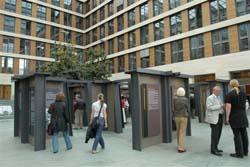31 July 2007

Photographer: Michail Miloslavski
A new exhibit on current antisemitic trends will open at the German Ministry of Foreign Affairs in Berlin on Wednesday, August 1, 2007. The exhibit, “Antisemitism? Anti-Zionism? Criticism of Israel?” will be on display in the Ministry’s courtyard before moving to the Technical University in Berlin, and elsewhere in Germany. It was produced with the support of the German Center for Political Education (Bundeszentral für Politische Bildung).
The exhibit, produced by Yad Vashem and the Center for Antisemitism Studies at the Technical University of Berlin, explores current antisemitic trends in Europe. Minister of State at the Federal Foreign Office Gernot Erler will address Wednesday’s opening, as will Yad Vashem Chairman Avner Shalev and Prof. Wolfgang Benz, Director of the Center for Antisemitism Studies at TU Berlin.
“This exhibit is timely and important, and its display in Germany is significant. The exhibit illustrates how 62 years after the Holocaust, antisemitism in Europe still exists, and that these insidious beliefs are alive and well - if in a new form,” said Shalev. “We must always be vigilant as antisemitism, whether classic, or in its current anti-Israel manifestation, attempts to make inroads and influence young people and the uninformed. Only through vigilance and education can we hope to combat this alarming phenomenon. That is why I am pleased that this exhibit will travel throughout Germany, and hopefully to other countries in Europe as well.”
Including some 45 panels, divided into thirteen chapters, the exhibit begins with a review of the Jews’ demography and richness of Jewish life, then a brief history of antisemitism, before focusing on current examples of antisemitic expressions over the past decade. “Classic” religious-based antisemitism of the extreme Christian right is presented side by side with the newer antisemitism that is often mixed with extreme anti-Israel sentiment and the violent language of Islamists and the radical left. The trivilialization and denial of the Holocaust that has become a mainstay of antisemites and its use as a rhetorical weapon, is examined as well. The exhibit looks at current expressions of antisemitism in the European media, through caricatures, photos, and more, as well as at antisemitic attacks in Europe, including violence and vandalism.
